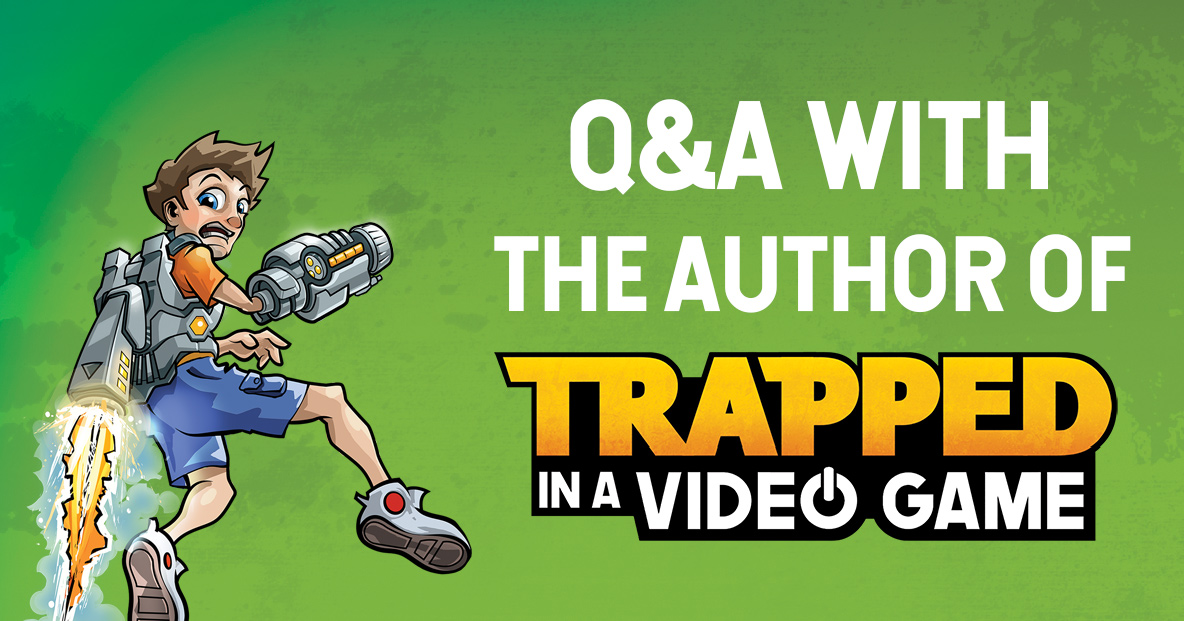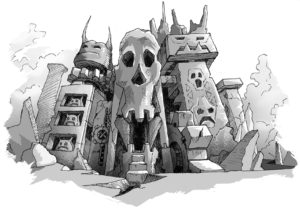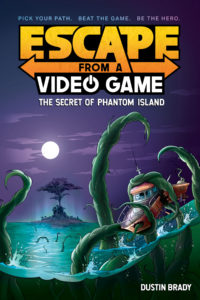
Author Dustin Brady first gamified reading with is his hit series Trapped in a Video Game, and now he’s back to bring action off the screen in an entirely new way with Escape from a Video Game, an all-new interactive adventure series! We caught up with Dustin for a quick Q&A to hear about how video games inspire his writing and why it’s so important to make reading fun for everyone. Check out the first three questions in the video, and then read the rest of the interview below!
AMP: Your recent middle-grade illustrated novels—the bestselling Trapped in a Video Game series, and now the interactive Escape From a Video Game—capture the action-packed excitement of video games in book form. In your own words, what does it mean to “gamify” reading, and what kind of impact do you hope your writing will make on kids?
Dustin Brady: It’s easy to get lost in a video game because you’re constantly immersed in action. With the Trapped series, I wanted to make kids feel like they were inside a game by pacing the story with nonstop action. Escape from a Video Game pushes that immersion a step further by “handing over the controller” to the reader. I’m hoping that readers will feel even more invested in the story, since they’re in charge of their own fate.
My goal with these stories is to connect with reluctant readers. Many kids who have a hard time getting through a few pages have no trouble mastering complicated video games. By bringing those games into books, we can help struggling readers stick with a story for longer than five minutes. Once kids truly get sucked into a story, I’ve found that they’re much more willing to give other books a try because they see how much fun reading can be.
AMP: Escape From a Video Game draws on two exciting sources: video games as a medium and Choose-Your-Own-Adventure stories. Did you read interactive fiction while growing up? If so, what stands out to you about those experiences?
DB: Yes, I loved interactive fiction books growing up! I specifically remember one called Inside UFO 54-40, which had a hidden ending you could only reach if you cheated. I tried to fill my new book with surprises like that. One thing I remember about those interactive books is that reaching a “good” ending felt super rewarding, but the “bad” endings could be frustrating because there were so many of them. I tried addressing this in the Escape series by making the “bad” endings surprising and funny, and also adding an achievement system that unlocks a secret story when readers find all the endings.

AMP: Huh, a secret ending, just like a real video game! Both Trapped and Escape celebrate how games and books can not only coexist, but also create new opportunities for literacy. What would you say to librarians who might be on the fence about endorsing video games for kids today?
DB: I understand the hesitation. It’s easy to see how overexposure to video games at a young age can hurt kids’ ability to focus on other things for long periods of time. I certainly don’t have all the answers to questions about screen time, but I do think books that incorporate video games are helpful for connecting with today’s gaming-obsessed youth. No matter how many video games most kids play per week, they want more. Books about video games provide an easy hook for capturing their imagination and show that reading doesn’t have to be a dreaded event.
AMP: That’s a powerful connection. On the other side of the spectrum, there are also many librarians and caregivers who have incorporated video games (particularly all-age sandboxes like Minecraft) into their educational philosophy, seeing such games (in moderation) as tools for creativity and cooperation. How do you incorporate the positive potential of video games into your books? And did you draw inspiration from specific games when planning your new interactive series?
DB: Beyond the initial interest hook that video games provide, I’ve been able to use gaming to introduce simple coding concepts. The Trapped series, for example, has a bonus section at the end of each book that uses activities and video games to teach coding principles. An underrated benefit of writing about video games is I get to annoy my wife by telling her I’m doing research whenever I’m gaming! I draw inspiration from a different genre for each book. The first book in the Escape series is an Indiana Jones-type of treasure-hunting adventure, so I drew inspiration from two franchises that do that really well: Tomb Raider and Uncharted.
AMP: LIGHTNING ROUND. Given the chance, what book would you adapt into a video game?
DB: It’d absolutely be that bonkers Charlie and the Chocolate Factory sequel where Charlie takes the glass elevator to a creepy space hotel and turns his grandparents into babies.
AMP: When did you first consider becoming a children’s author, and why?
DB: I loved books that were action-packed and funny when I was a kid, and I remember thinking that I wanted to write stories like that someday. Of course, I also wanted to be a professional baseball player and a spy, but at least I achieved one dream.
AMP: If you could give a ONE-WORD teaser for your favorite part of Escape From a Video Game, what would it be?
DB: Delight. I want readers to think, “I didn’t know a book could do THAT,” then read 10 more books to find out what else a good story can do.
Escape from a Video Game is available now, wherever books are sold.

